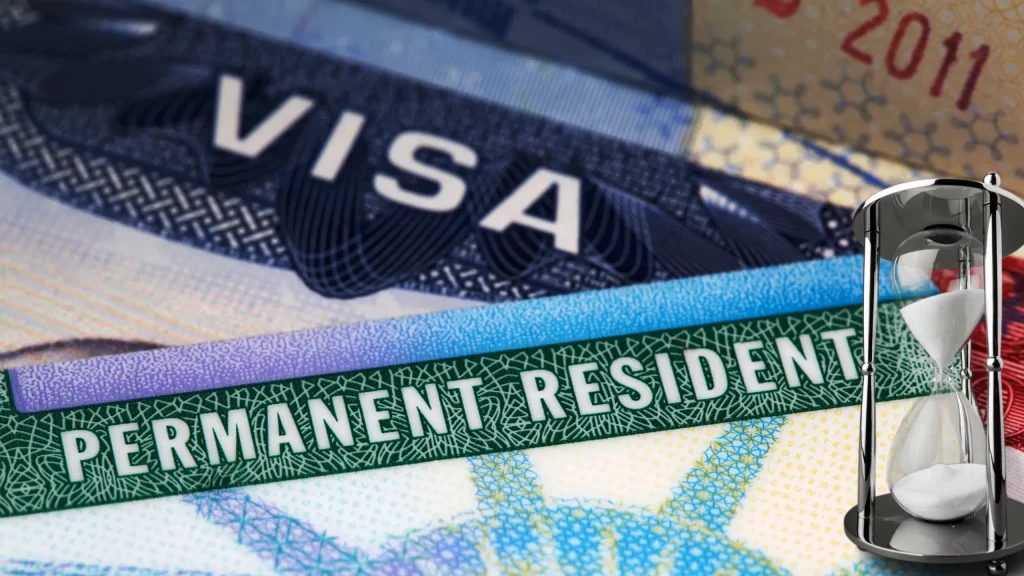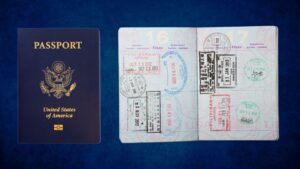“Green Card” is a U.S. government-issued ID given to foreign-born individuals who have legal permission to live and work permanently in the United States. Green cards, which are also officially called Permanent Resident Cards, are issued by the U.S. Citizenship and Immigration Services (USCIS). Although the United States has become more difficult to immigrate to in recent years, it has historically been both easy to immigrate to and the world’s leading destination country for immigrants. As such, the Green Card system receives a high volume of applicants, who come from a vast range of situations. Individuals who wish to apply for a Green Card must be eligible under one of the eight general categories, many of which have a limited number of Green Cards available each year.
Green Card Categories
Every year 140,000 applicants are given US green card in employment based categories. Within that 140,000, each country can have cap, which is 7% of 140,000 green card (9,800).
They are further divided into five categories as follows
- EB1 – Priority Workers
- EB2 – Professionals with advanced degrees or persons with exceptional ability
- EB3 – Skilled or professional workers
- EB4 – Special Immigrants
- EB5 – Investors (Employment Creation)
How Long to Get Green Card
According to May Visa Bulletin 2025
| Employment- Based | All Chargeability Areas Except Those Listed | China – mainland born | INDIA | MEXICO | PHILIPPINES |
| EB1 | C | C | C | C | C |
| EB2 | C | 15APR09 | 15NOV04 | C | C |
| EB3 | 01OCT12 | 01OCT12 | 01OCT03 | 01OCT12 | 01NOV07 |
The above table shows the priority dates for EB1, EB2 and EB3 categories for India and China.
If you apply for Green card in EB1 Category, you can get it in GC in less than one year.
- C = Priority Date in Current
- No PERM labor Process for EB1 category.
- I-140 and I-485 applications can be filed concurrently.
For EB-2 Green Card submitted on November 15, 2024 is being processed for Indian Nationals ( born in India).
That’s about 10 years wait. But, in theory, it takes about 4 to 6 years.
Eight Categories of Green Card Eligibility
- Green Card through Family — Applicant is the spouse, fiancée, child/stepchild, parent, sibling, widow, or widower of a U.S. citizen.
- Green Card through Employment — Applicant has sought-after job skills or is investing heavily in a business that will create at least 10 full-time jobs.
- Green Card as a Special Immigrant — Applicant is working for a nonprofit religious organization, is a juvenile who needs protection from an abusive parent, is an Afghan or Iraqi national who worked for U.S. government, or meets certain additional criteria as an international broadcaster or employee/retiree of certain international organizations.
- Green Card through Refugee or Asylum Status — Applicant was admitted as a refugee or given asylum status at least 1 year prior.
- Green Card for Human Trafficking and Crime Victims — Applicant is a victim of human trafficking or certain other crimes and granted a T or U nonimmigrant visa.
- Green Card for Victims of Abuse — Applicant is abused spouse, child, or parent of U.S. citizen, Cuban native, or other lawful permanent U.S. resident. Special Immigrant Juveniles are also eligible.
- Green Card through Other Categories — Applicant meets one of several rare and specific criteria such as being an American Indian born in Canada, a foreign diplomat who cannot return home, or the winner of a green card lottery.
- Green Card through Registry — Applicant has lived in the U.S. since before Jan 01, 1972.
The Green Card Application Process:
- An immigrant petition is submitted on behalf of the candidate by a sponsor—in most cases, a U.S. relative or employer. Some applicants (such as investors) may be eligible to file for themselves.
- If USCIS approves the immigrant petition, one of two next steps occurs, depending upon the applicant’s eligibility category and country of origin. Applicants in category F2A (immediate spouses, unmarried children under 21 years of age, often parents of a U.S. green card holder) typically proceed straight to the next step (visa adjudication, steps 5 or 7). However, applicants in the other family-based categories (F1, F2B, F3, F4) are typically given a priority date, placed on a waitlist, and told to watch the US State Department’s monthly updates to the application date list. Applicants in employment-based categories (EB1-EB5) are usually processed straightaway, though individuals from China, Mexico, or Central America may be wait-listed in certain categories.
- Application dates are assigned to each individual country/category combination (China F1, Japan EB2, etc.) and are nearly always dates in the past. However, as the USCIS assigns each month’s allotment of immigrant visa numbers in each specific category, the application date is gradually moved forward. Once the application date in the applicant’s chosen eligibility category is equal to (or more recent than) an applicant’s priority date, the applicant is free to submit their additional required documents via one of two application processes—an adjustment of status (AOS) or consular processing—depending upon where they currently reside.
- The first process (adjustment of status) is designed for applicants who have already legally entered the U.S. (for example, via a temporary work visa). These applicants file an adjustment of status application with the USCIS. (For the second possible process, skip to step 7.)
- The USCIS receives the application and researches the applicant. A background check is performed and the applicant’s fingerprints, photo, and signature are recorded. The applicant is interviewed and spouses and other sponsors may also be interviewed. Once the research and interview processes are completed, the USCIS makes its decision and mails either a rejection letter or a Green Card to the applicant’s most recent address.
- The second possible process, consular processing, is designed for applicants who do not yet reside in the United States (or who are otherwise ineligible for an AOS application). The process of screening and interviewing is quite similar, but is performed through representatives at the U.S. consulate or embassy in the applicant’s current home country instead of by the USCIS.
- If the applicant passes the screening process, they are issued an immigrant visa that enables them to travel to the U.S., where they are made a permanent resident upon their arrival and mailed a Green Card within approximately four months.
Green Card Waitlist Explained – Priority Dates, Application Dates and How They Interact
Thousands of people apply for green cards each year. This volume of applications often results in months- or years-long wait times for applicants in most categories. To help manage applicants’ expectations and streamline processing, the U.S. Department of State uses a waitlist system based around two specific dates: the priority date and the application date.
- Priority date — Represents the applicant’s place in the virtual queue. The priority date is assigned to the applicant upon acceptance of their initial immigrant petition by the USCIS.
- Application date — Represents the virtual queue itself. The application date, which is nearly always a date in the past, is different for each specific country and eligibility class (say, India F3) and gradually moves forward in time as applications are processed. The U.S. Department of State releases a monthly visa bulletin that indicates the current application dates for each category and country-of-origin.
Priority dates and application dates work in tandem. When an applicant’s application date has moved far enough forward that it is either the same as or more recent than that applicant’s priority date, it is an indication that the applicant has reached the front of the virtual line. An immigrant visa number is available to them and they are free to submit their additional paperwork to USCIS (specifically to the Department of State’s National Visa Center) and proceed with their application process.
The data below indicate the application dates for each country and category as of November 2023. However, the dates can change each month. Interested parties are encouraged to consult the U.S. State Department Visa Bulletin page for the most recent dates.
Visa Bulletin for March 2025
The latest green card waiting lists as of March 2025
The U.S. Department of State released its Visa Bulletin for March 2025. This monthly update is important if you’re waiting for a green card because it shows how long you might have to wait.
Every month, USCIS announces whether applicants already living in the United States should file their “adjustment of status” applications based on the “Final Action Dates” or the “Dates for Filing.” For March, family-based applicants must use the “Dates for Filing” (available on the State Department’s website), while employment-based applicants must use the “Final Action Dates” (also available on the State Department’s website).
In March, there were changes in all employment-based categories, except in the EB-1 category. The biggest changes were in the EB-4 category, with a 1-year and 1-month retrogression for all countries. There were no changes in wait times for family-based categories.
What is the Visa Bulletin?
- The Visa Bulletin lists priority dates, which are like placeholders in the green card application line.
- Each month, the U.S. Department of State calculates how many applications are waiting in each category. This helps them estimate when different applicants might be able to move forward.
- Dates for Filing: These are the dates listed in the Visa Bulletin. If your priority date is before the cut-off date listed for your category, you can take the next step in the application process. If your priority date is the same as the cut-off date, you are not yet eligible to move forward in the application process.
- Final Action Dates: The Visa Bulletin also shows “Final Action Dates.” This is an estimate of when your application will actually be processed and decided upon. The difference between these two dates roughly reflects the expected USCIS processing time.
- There are two ways to move forward when your priority date is current:
- Filing for Adjustment of Status: If you’re already living in the U.S.
- Applying for an Immigrant Visa: If you’re living outside the U.S.
Family-Based Green Card Wait Times
| Category | General Visa Bulletin Wait | Country-Specific Backlogs | I-140 Processing Time for EB Visa | Additional I-485 Processing Time for Green Card |
| EB-1 | Current (No Wait) | China: Since Jan 2023 India: Since April 2022 | 7.6 months (15 days premium and 45 days for EB-1 multinational manager) | months |
| EB-2 | Current (No Wait) | China: Since Oct 2020 India: Since Jan 2013 | 7.6 months (15 days premium and 45 days for EB-2 National Interest Waiver) | months |
| EB-3 | Since March 2025 | China: Since Nov 2020 India: Since June 2013 | 7.6 months (15 days premium) | months |
| EB-4 | Since Feb 2025 | Same for all countries | 7.6 months (premium N/A) | months |
| EB-5 | Current (No Wait) | China: Since Oct 2016 India: Since April 2022 | 70.8 months | months |
Most employment-based (EB) green cards require an approved I-140 petition (or I-360/I-526 for specific categories) before filing Form I-485 (the actual green card application). For EB-2 and EB-3 categories, PERM labor certification is typically required before the I-140 can be submitted. Here’s a breakdown of the current processing timeline:
1. PERM Labor Certification (If Required)
✔ Required for most EB-2 and EB-3 cases
✔ Current processing time: ~388 days
✔ Not required for EB-1, EB-4, EB-5, and select EB-2 (National Interest Waiver) cases
2. Form I-140 Petition Processing
✔ Standard processing time: ~7.6 months
✔ Premium processing (if eligible): 15 days
3. Visa Bulletin Waiting Period
✔ Varies by category and country of chargeability
✔ No fixed timeline – depends on visa availability
4. Form I-485 (Adjustment of Status) Processing
✔ Timeline varies based on USCIS workload
✔ Processing starts once the priority date is current
5. Expedited Processing Options
✔ Premium Processing (15 days) for:
- EB-1 Extraordinary Ability
- EB-2 & EB-3 standard categories
✔ Premium Processing (45 business days) for: - EB-1 Multinational Managers
- EB-2 National Interest Waiver (NIW)
✔ Expedited Processing for EB-5 cases under special circumstances
What These Times Mean for You: Understanding Green Card Wait Periods
Getting a green card typically involves two major waiting periods:
1. Visa Bulletin Wait
Most green card applicants must track the Visa Bulletin, a monthly update that lists “cut-off” dates for different categories. Your priority date (the date your petition was filed) must be earlier than the listed cut-off date before you can proceed.
- Factors That Affect Wait Time:
- Your country of birth
- Your green card category (family-based, employment-based, etc.)
- The annual visa quota for your category
Wait times can range from months to several years, depending on demand.
2. USCIS Processing Time
Once your priority date is current, you can file your green card application with USCIS. Processing times vary based on:
- Application type (family-sponsored, employment-based, etc.)
- USCIS service center workload
This stage can take several months to over a year.
Who Doesn’t Have to Wait for the Visa Bulletin?
✅ Immediate Relatives of U.S. Citizens (spouses, unmarried children under 21, and parents of U.S. citizens over 21) can apply for a green card immediately—no Visa Bulletin wait required.
✅ Employment-Based Applicants with PERM must first complete PERM Labor Certification (which takes 18-24 months) before their Visa Bulletin wait even begins. Once certified, the employer files Form I-140 to set the priority date.
Key Takeaways
- Your total wait time = Visa Bulletin wait + USCIS processing time
- Immediate relatives of U.S. citizens can apply without a visa wait
- Consult an immigration attorney or check the USCIS website for case-specific updates
Understanding these wait times helps you plan ahead and navigate the green card process effectively.
Country-Specific Wait Time Impact
Applicants from certain countries face significantly longer initial waiting periods:
- India: Particularly long waits for EB-2 and EB-3 categories
- China: Extended waits for all employment-based categories
- Mexico: Longer waits for most family preference categories
- Philippines: Extended waits for F4 (sibling) category
Monitoring Your Wait Time
The two key resources for tracking your wait time are:
- The monthly visa bulletin: Shows which priority dates are currently being processed
- USCIS processing times: Shows how long the agency is taking to process applications
FAQs
1. How long does it take to get a green card in the USA?
The wait time varies depending on the green card category, country of birth, and Visa Bulletin priority date. It can take months to over 10 years for some applicants.
2. How does the Visa Bulletin affect my green card wait time?
The Visa Bulletin determines when you can apply for a green card based on your priority date. If your category is backlogged, you may need to wait years before filing.
3. Which countries have the longest wait times for U.S. green cards?
Applicants from India, China, Mexico, and the Philippines often face the longest delays due to high demand.
4. Do immediate relatives of U.S. citizens have to wait for a green card?
No. Spouses, unmarried children under 21, and parents of U.S. citizens over 21 can apply without waiting for visa availability.
5. How long is the green card wait time for UK citizens?
UK citizens applying for a U.S. green card under employment or family-based categories typically experience shorter wait times compared to applicants from India or China.
6. Can Canadians get a U.S. green card faster?
Canadians may qualify for faster processing under NAFTA/USMCA work visas (like the TN visa), but they must still go through standard green card procedures.
7. How long is the green card wait time for Canada?
Canada’s Express Entry system for permanent residency typically takes 6-12 months, which is faster than most U.S. green card processes.
8. Can I speed up my green card processing in the USA?
Some employment-based green cards (EB-1, EB-2 with National Interest Waiver) qualify for premium processing, reducing Form I-140 processing time to 15 days. However, Visa Bulletin waits still apply.
9. How does the PERM process impact green card wait times?
For many employment-based green cards (EB-2, EB-3), PERM Labor Certification must be completed before filing Form I-140. PERM can take 18-24 months, adding to the wait time.
10. How long is the family-sponsored green card wait time?
- Immediate relatives (spouse, parents, minor children) → No wait
- Siblings of U.S. citizens → 10+ years
- Spouses/children of green card holders → 2-5 years
11. What happens if my priority date is current?
Once your priority date is current, you can file your green card application (Form I-485 or DS-260). The final USCIS processing time varies but typically takes 6-12 months.
12. Does Brexit affect UK citizens applying for a U.S. green card?
No. Brexit does not change U.S. immigration policies for UK citizens. The green card process remains the same.
13. Can I work while waiting for my U.S. green card?
Yes, if you apply for Adjustment of Status (AOS) in the U.S., you can request a work permit (EAD) while your green card application is pending.
14. What is the green card wait time for EB-1 applicants?
EB-1 (priority workers) often have shorter wait times compared to EB-2/EB-3. However, Indian and Chinese applicants face significant backlogs.
15. Where can I check my green card wait time?
You can check:
- Visa Bulletin (travel.state.gov) for priority dates
- USCIS Processing Times (uscis.gov) for case status updates
- Department of State for consular processing timelines
16. What is my priority date?
This is usually the date your green card application petition was initially filed. Check your paperwork or consult with an immigration attorney if you’re unsure.
17. What if my country has a backlog?
Some countries have longer wait times than others due to high demand. This means cut-off dates may move slower and sometimes even go backward (this is called retrogression).
18. How long will I have to wait?
The Visa Bulletin can’t give you an exact answer. The wait time depends on your category and country backlog. It’s helpful to track patterns in your category over multiple months to get a better sense.







